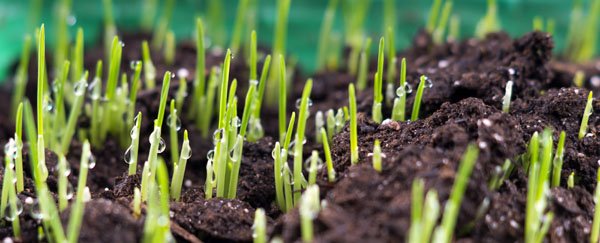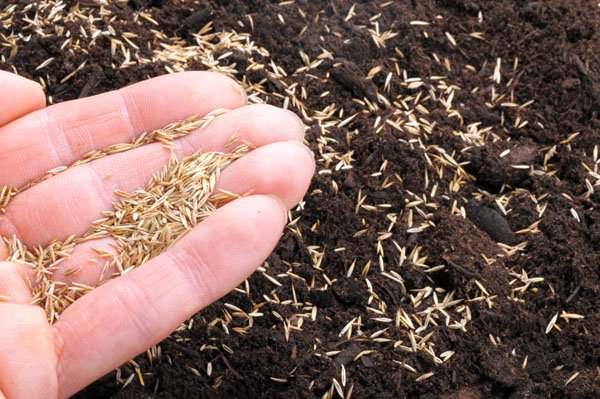Grass Seed Germination
Step by Step Process
It is my hope that this page will change your understanding of Grass Seed Germination and give you more success when planting or overseeding a lawn. Here is what I hope you will gain from reading this page:
- Learning the steps of seed germination will reinforce your knowledge of planting a lawn and encourage better maintenance practices.
- Knowing what is required for a seed to germinate will answer the question: "Why is it done this way?"
Introduction to Plant Seed Biology
There are many types of lawn grass seed, but the early stages of seed germination are basically the same. The advantage of planting a lawn is that we can provide some of the necessary ingredients to make grass seed germination easier. We can provide the necessary moisture, proper soil conditions, and the timing when the seed is planted.
It is not always so in nature. The process of seed development
and germination is not so simple for many other plant and tree seeds.
Many seeds will not germinate until seed preparation and environmental
conditions line up perfectly. Some seeds may not germinate for dozens of
years. However, when things are finally ready, most seeds will need
three primary external elements.
If you have ever purchased any seed, then you know that most seed is very dry. This is because seed development goes through several processes before it is ready for germination.
A seed begins with a division of a fertilized egg within the embryo sac. As the embryo develops, growth within the seed continues until it reaches a certain point. At a specific point, embryo growth is halted until the seed matures and is either collected or falls from the plant onto the ground. Embryo growth is resumed again at the start of germination. The beginning of seed germination begins with water.
Importance of Water for Grass Seed Germination
As stated above, grass seed is very dry at the time of planting. On average, less than 10 percent of a seed’s total weight is water. Therefore, before a seed can germinate it must absorb water. This is called "imbibition". Water is necessary to activate the seed and begin the process of germination.
During imbibition, the seed swells considerably. Dormant enzymes are activated. New enzymes are also developed during imbibition that help the seed to utilize stored food created during embryo development. As internal cell division begins, there must be sufficient soil moisture to supply a continuous source of water and nutrients to the seed. This is the reason why the soil must remain damp until the seed has completed germination and has sprouted.
When grass seed germination is completed and the seed has sprouted, sufficient soil moisture is still necessary. The short roots are still developing, so frequent, but not heavy irrigation will be needed until the roots have developed some depth. Saturated soils can lower oxygen levels and encourage root diseases.
The Importance of Oxygen in Grass Seed Germination
The seed operates in an anaerobic manner during the initial stages of water absorption at the start of germination. This continues until the seed coat ruptures. Once the seed coat ruptures the seed moves from being anaerobic (not requiring oxygen) to aerobic (requires a steady supply of oxygen). This process of oxygen exchange in plants is called “transpiration.”
Therefore, it is very important to make sure the soil is damp, but not waterlogged. Waterlogged soil decreases the amount of oxygen available to the seed. If saturated soil conditions are prolonged, the seed can perish.
Planting in good soil is also important for oxygen exchange. Heavy clay soil may hold water well, but can easily compact, which reduces oxygen levels. Loamy soils are better for planting seed. Soils with a high volume of sand may have good oxygen levels, but do not hold water very well.
The Importance of Temperature in Seed Germination
Different seed types have slightly different preferred temperature ranges for germination. However, the important thing to remember is that seed will have a minimum and maximum temperature. If the temperature is outside of those limits the seed will not germinate.
The majority of lawn grass seed will germinate in an average soil temperature range of 80 degrees. Keep in mind that most seed types will still germinate in temperature variations of plus or minus 15 degrees from average. A little research on your seed variety will give you the best temperature range for planting
In contrast, some early season vegetable plant seeds can germinate in considerably cooler soil temperatures.
Lawn Care Academy Sitemap
Easily find any page on our site by using our sitemap. Pages are listed under categories for ease in searching.
Understanding Organic Biostimulants
Organic biostimulants are used to make fertilizers more efficient,
increase soil nutrient availability, promote faster plant growth,
promote plant health, and gain better results using less fertilizer. See
modern philosophy and case studies that test the popular methods.
Soil Nutrients and Nutrient Cycles
Why do home lawns need fertilizer and forest, prairies, marshes, and
the like do not? This page provides insightful information into the
biology of soil nutrients and nutrient cycles and how it relates to home
lawns.
Plant Transpiration Explained
Plant transpiration is an essential process in plants and is closely
tied to photosynthesis. This page explains the basics of transpiration
and its effect on plants.
Understanding Plant Photosynthesis
Photosynthesis made easy! Understanding basic plant function will
greatly improve your lawn care, especially fertilization. You will never
look at your grass the same way.
Plant Structure and Growth Habits
In the world of turf grass, understanding plant structure and growth
can provide helpful insights to maintaining a beautiful lawn.
Science and Benefits of Plant Growth Regulators
Plant Growth Regulators are just beginning to be discovered by
homeowners. They are fantastic products with dozens of uses for
everything from slowing grass growth to eliminating unwanted tree fruit.
Click here to discover what you have been missing.
Grass Seed Germination back to Lawn Care Academy Home


